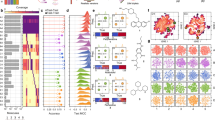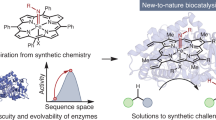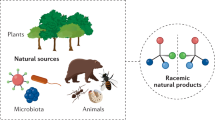Abstract
Spurred by advancements in microbial genetics and enzyme engineering, chemoenzymatic strategies, which combine enzymatic and synthetic transformations, have increasingly made an impact in the synthesis of bioactive natural products, pharmaceutical components and other valuable molecules. Beyond target-oriented synthesis, researchers have also leveraged chemoenzymatic approaches in structure–activity relationship (SAR) studies of bioactive natural products by using enzymatic reactions in either the early-stage construction of key building blocks or the late-stage modification of key intermediates. This Review summarizes the applications of chemoenzymatic approaches for SAR exploration of natural products, categorizing the case studies according to the stage in which the enzymatic reactions are performed. Current challenges in the field are also discussed, along with emerging technologies that may provide solutions to these challenges in the future.

This is a preview of subscription content, access via your institution
Access options
Subscribe to this journal
Receive 12 digital issues and online access to articles
118,99 € per year
only 9,92 € per issue
Buy this article
- Purchase on SpringerLink
- Instant access to full article PDF
Prices may be subject to local taxes which are calculated during checkout









Similar content being viewed by others
Change history
25 September 2023
A Correction to this paper has been published: https://doi.org/10.1038/s44160-023-00421-4
References
Crum-Brown, A. & Fraser, T. The connection of chemical constitution and physiological action. Trans. R. Soc. Edinburgh 25, 257 (1865).
Okano, A., Isley, N. A. & Boger, D. L. Total syntheses of vancomycin-related glycopeptide antibiotics and key analogues. Chem. Rev. 117, 11952–11993 (2017).
Wright, P. M., Seiple, I. B. & Myers, A. G. The evolving role of chemical synthesis in antibacterial drug discovery. Angew. Chem. Int. Ed. 53, 8840–8869 (2014).
Li, Q. et al. Synthetic group A streptogramin antibiotics that overcome Vat resistance. Nature 586, 145–150 (2020).
Sears, J. E. & Boger, D. L. Total synthesis of vinblastine, related natural products, and key analogues and development of inspired methodology suitable for the systematic study of their structure–function properties. Acc. Chem. Res. 48, 653–662 (2015).
Nestl, B. M., Hammer, S. C., Nebel, B. A. & Hauer, B. New generation of biocatalysts for organic synthesis. Angew. Chem. Int. Ed. 53, 3070–3095 (2014).
Ramsden, J. I., Cosgrove, S. C. & Turner, N. J. Is it time for biocatalysis in fragment-based drug discovery? Chem. Sci. 11, 11104–11112 (2020).
Wu, S., Snajdrova, R., Moore, J. C., Baldenius, K. & Bornscheuer, U. T. Biocatalysis: enzymatic synthesis for industrial applications. Angew. Chem. Int. Ed. 60, 88–119 (2021).
Amatuni, A., Shuster, A., Adibekian, A. & Renata, H. Concise chemoenzymatic total synthesis and identification of cellular targets of cepafungin I. Cell Chem. Biol. 27, 1318–1326 (2020).
Zwick, C. R., Sosa, M. B. & Renata, H. Modular chemoenzymatic synthesis of GE81112 B1 and related analogues enables elucidation of its key pharmacophores. J. Am. Chem. Soc. 143, 1673–1679 (2021).
Tanifuji, R. et al. Chemo-enzymatic total syntheses of jorunnamycin A, saframycin A, and N-Fmoc saframycin Y3. J. Am. Chem. Soc. 140, 10705–10709 (2018).
Lowell, A. N. et al. Chemoenzymatic total synthesis and structural diversification of tylactone-based macrolide antibiotics through late-stage polyketide assembly, tailoring, and C–H functionalization. J. Am. Chem. Soc. 139, 7913–7920 (2017).
Schmidt, J. J. et al. A versatile chemoenzymatic synthesis for the discovery of potent cryptophycin analogs. ACS Chem. Biol. 15, 524–532 (2020).
Kopp, F., Grünewald, J., Mahlert, C. & Marahiel, M. A. Chemoenzymatic design of acidic lipopeptide hybrids: new insights into the structure–activity relationship of daptomycin and A54145. Biochemistry 45, 10474–10481 (2006).
Scull, E. M. et al. Chemoenzymatic synthesis of daptomycin analogs active against daptomycin-resistant strains. Appl. Microbiol. 104, 7853–7865 (2020).
Xie, K., Zhang, X., Sui, S., Ye, F. & Dai, J. Exploring and applying the substrate promiscuity of a C-glycosyltransferase in the chemo-enzymatic synthesis of bioactive C-glycosides. Nat. Commun. 11, 5162 (2020).
Li, F., Zhang, X. & Renata, H. Enzymatic CH functionalizations for natural product synthesis. Curr. Opin. Chem. Biol. 49, 25–32 (2019).
Shoji, J. et al. Isolation of cepafungins I, II and III from Pseudomonas species. J. Antibiot. 43, 783–787 (1990).
Stein, M. L. et al. One-shot NMR analysis of microbial secretions identifies highly potent proteasome inhibitor. Proc. Natl Acad. Sci. USA 109, 18367–18371 (2012).
Schmidt, U., Kleefeldt, A. & Mangold, R. The synthesis of glidobactin A. J. Chem. Soc. Chem. Commun. 1992, 1687–1689 (1992).
Krahn, D., Ottmann, C. & Kaiser, M. The chemistry and biology of syringolins, glidobactins and cepafungins (syrbactins). Nat. Prod. Rep. 28, 1854–1867 (2011).
Amatuni, A. & Renata, H. Identification of a lysine 4-hydroxylase from the glidobactin biosynthesis and evaluation of its biocatalytic potential. Org. Biomol. Chem. 17, 1736–1739 (2019).
Amatuni, A., Shuster, A., Abegg, D., Adibekian, A. & Renata, H. Comprehensive structure–activity relationship studies of cepafungin enabled by biocatalytic C–H oxidations. ACS Cent. Sci. 9, 239–251 (2023).
Brandi, L. et al. Novel tetrapeptide inhibitors of bacterial protein synthesis produced by a Streptomyces sp. Biochemistry 45, 3692–3702 (2006).
Jürjens, G. et al. Total synthesis and structural revision of the antibiotic tetrapeptide GE81112A. Angew. Chem. Int. Ed. 57, 12157–12161 (2018).
Zwick, C. R. III, Sosa, M. B. & Renata, H. Characterization of a citrulline 4-hydroxylase from nonribosomal peptide GE81112 biosynthesis and engineering of its substrate specificity for the chemoenzymatic synthesis of enduracididine. Angew. Chem. Int. Ed. 58, 18854–18858 (2019).
Le, V. H., Inai, M., Williams, R. M. & Kan, T. Ecteinascidins. A review of the chemistry, biology and clinical utility of potent tetrahydroisoquinoline antitumor antibiotics. Nat. Prod. Rep. 32, 328–347 (2015).
Leal, J. et al. PM01183, a new DNA minor groove covalent binder with potent in vitro and in vivo anti-tumour activity. Br. J. Pharmacol. 161, 1099–1110 (2010).
Scott, J. D. & Williams, R. M. Chemistry and biology of the tetrahydroisoquinoline antitumor antibiotics. Chem. Rev. 102, 1669–1730 (2002).
Koketsu, K., Watanabe, K., Suda, H., Oguri, H. & Oikawa, H. Reconstruction of the saframycin core scaffold defines dual Pictet–Spengler mechanisms. Nat. Chem. Biol. 6, 408–410 (2010).
Tanifuji, R., Haraguchi, N. & Oguri, H. Chemo-enzymatic total syntheses of bis-tetrahydroisoquinoline alkaloids and systematic exploration of the substrate scope of SfmC. Tetrahedron Chem 1, 100010 (2022).
Tanifuji, R., Tsukakoshi, K., Ikebukuro, K., Oikawa, H. & Oguri, H. Generation of C5-desoxy analogs of tetrahydroisoquinoline alkaloids exhibiting potent DNA alkylating ability. Bioorg. Med. Chem. Lett. 29, 1807–1811 (2019).
Kishi, T., Harada, S., Yamana, H. & Miyake, A. Studies on juvenimicin, a new antibiotic. II. Isolation, chemical characterization and structures. J. Antibiot. 29, 1171–1181 (1976).
Kinumaki, A., Harada, K. I., Suzuki, T., Suzuki, M. & Okuda, T. Macrolide antibiotics M-4365 produced by Micromonospora. II. Chemical structures. J. Antibiot. 30, 450–454 (1977).
DeMars, M. D. et al. Biochemical and structural characterization of MycCI, a versatile P450 biocatalyst from the mycinamicin biosynthetic pathway. ACS Chem. Biol. 11, 2642–2654 (2016).
Oh, H.-S. & Kang, H.-Y. Total synthesis of pikromycin. J. Org. Chem. 77, 1125–1130 (2012).
Matsumoto, T., Maeta, H., Suzuki, K. & Tsuchihashi, L. G. First total synthesis of mycinamicin IV and VII.: successful application of new glycosidation reaction. Tetrahedron Lett. 29, 3575–3578 (1988).
Magarvey, N. A. et al. Biosynthetic characterization and chemoenzymatic assembly of the cryptophycins. Potent anticancer agents from nostoc cyanobionts. ACS Chem. Biol. 1, 766–779 (2006).
Ding, Y., Rath, C. M., Bolduc, K. L., Håkansson, K. & Sherman, D. H. Chemoenzymatic synthesis of cryptophycin anticancer agents by an ester bond-forming non-ribosomal peptide synthetase module. J. Am. Chem. Soc. 133, 14492–14495 (2011).
Schwartz, R. E. et al. Pharmaceuticals from cultured algae. J. Ind. Microbiol. 5, 113–123 (1990).
D’Agostino, G. et al. A multicenter phase II study of the cryptophycin analog LY355703 in patients with platinum-resistant ovarian cancer. Int. J. Gynecol. Cancer 16, 71–76 (2006).
Su, D. et al. Modulating antibody–drug conjugate payload metabolism by conjugation site and linker modification. Bioconjug. Chem. 29, 1155–1167 (2018).
Verma, V. A. et al. The cryptophycins as potent payloads for antibody drug conjugates. Bioorg. Med. Chem. Lett. 25, 864–868 (2015).
Weiss, C., Sammet, B. & Sewald, N. Recent approaches for the synthesis of modified cryptophycins. Nat. Prod. Rep. 30, 924–940 (2013).
Beck, Z. Q., Aldrich, C. C., Magarvey, N. A., Georg, G. I. & Sherman, D. H. Chemoenzymatic synthesis of cryptophycin/arenastatin natural products. Biochemistry 44, 13457–13466 (2005).
Bolduc, K. L., Larsen, S. D. & Sherman, D. H. Efficient, divergent synthesis of cryptophycin unit A analogues. Chem. Commun. 48, 6414–6416 (2012).
Baltz, R. H., Miao, V. & Wrigley, S. K. Natural products to drugs: daptomycin and related lipopeptide antibiotics. Nat. Prod. Rep. 22, 717–741 (2005).
Raja, A., LaBonte, J., Lebbos, J. & Kirkpatrick, P. Daptomycin. Nat. Rev. Drug Discov. 2, 943–944 (2003).
Cottagnoud, P. et al. Daptomycin is highly efficacious against penicillin-resistant and penicillin- and quinolone-resistant pneumococci in experimental meningitis. Antimicrob. Agents Chemother. 48, 3928–3933 (2004).
Robbel, L. & Marahiel, M. A. Daptomycin, a bacterial lipopeptide synthesized by a nonribosomal machinery. J. Biol. Chem. 285, 27501–27508 (2010).
Grünewald, J., Sieber, S. A., Mahlert, C., Linne, U. & Marahiel, M. A. Synthesis and derivatization of daptomycin: a chemoenzymatic route to acidic lipopeptide antibiotics. J. Am. Chem. Soc. 126, 17025–17031 (2004).
Lam, H. Y. et al. Total synthesis of daptomycin by cyclization via a chemoselective serine ligation. J. Am. Chem. Soc. 135, 6272–6279 (2013).
Barnawi, G. et al. An entirely fmoc solid phase approach to the synthesis of daptomycin analogs. Peptide Sci. 111, e23094 (2019).
He, Y. et al. Reduced pulmonary surfactant interaction of daptomycin analogs via tryptophan replacement with alternative amino acids. Bioorg. Med. Chem. Lett. 22, 6248–6251 (2012).
Elshahawi, S. I. et al. Structure and specificity of a permissive bacterial C-prenyltransferase. Nat. Chem. Biol. 13, 366–368 (2017).
Hoffmeister, D., Dräger, G., Ichinose, K., Rohr, J. & Bechthold, A. The C-glycosyltransferase UrdGT2 is unselective toward d- and l-configured nucleotide-bound rhodinoses. J. Am. Chem. Soc. 125, 4678–4679 (2003).
Chen, D. et al. Probing the catalytic promiscuity of a regio- and stereospecific C-glycosyltransferase from Mangifera indica. Angew. Chem. Int. Ed. 54, 12678–12682 (2015).
Simić, S. et al. Shortening synthetic routes to small molecule active pharmaceutical ingredients employing biocatalytic methods. Chem. Rev. 122, 1052–1126 (2022).
Hong, B., Luo, T. & Lei, X. Late-stage diversification of natural products. ACS Cent. Sci. 6, 622–635 (2020).
Marshall, J. R. et al. Screening and characterization of a diverse panel of metagenomic imine reductases for biocatalytic reductive amination. Nat. Chem. 13, 140–148 (2021).
Zhang, C. et al. Exploiting the reversibility of natural product glycosyltransferase-catalyzed reactions. Science 313, 1291–1294 (2006).
Gao, L. et al. Enzymatic control of endo- and exo-stereoselective Diels–Alder reactions with broad substrate scope. Nat. Catal. 4, 1059–1069 (2021).
Baek, M. et al. Accurate prediction of protein structures and interactions using a three-track neural network. Science 373, 871–876 (2021).
Mazurenko, S., Prokop, Z. & Damborsky, J. Machine learning in enzyme engineering. ACS Catal. 10, 1210–1223 (2020).
Jacques, P. et al. High-throughput strategies for the discovery and engineering of enzymes for biocatalysis. Bioprocess. Biosyst. Eng. 40, 161–180 (2017).
Acknowledgements
We thank the National Institute of General Medical Sciences (grant R35 GM128895) for support with the writing of this manuscript and with our laboratory’s studies in this area. All enzyme structures were prepared using UCSF Chimera (version 1.16). H.R. is a CPRIT scholar in cancer research.
Author information
Authors and Affiliations
Contributions
H.R. conceived of the scope of this Review. F.L., H.D. and H.R. wrote and edited the manuscript.
Corresponding author
Ethics declarations
Competing interests
The authors declare no competing interests.
Peer review
Peer review information
Nature Synthesis thanks Xiaoguang Lei and the other, anonymous, reviewer(s) for their contribution to the peer review of this work. Primary Handling Editor: Thomas West, in collaboration with the Nature Synthesis team.
Additional information
Publisher’s note Springer Nature remains neutral with regard to jurisdictional claims in published maps and institutional affiliations.
Rights and permissions
Springer Nature or its licensor (e.g. a society or other partner) holds exclusive rights to this article under a publishing agreement with the author(s) or other rightsholder(s); author self-archiving of the accepted manuscript version of this article is solely governed by the terms of such publishing agreement and applicable law.
About this article
Cite this article
Li, F., Deng, H. & Renata, H. Chemoenzymatic approaches for exploring structure–activity relationship studies of bioactive natural products. Nat. Synth 2, 708–718 (2023). https://doi.org/10.1038/s44160-023-00358-8
Received:
Accepted:
Published:
Issue Date:
DOI: https://doi.org/10.1038/s44160-023-00358-8
This article is cited by
-
Contrastive learning-based drug screening model for GluN1/GluN3A inhibitors
Acta Pharmacologica Sinica (2025)
-
Chemoenzymatic total synthesis of alchivemycin A
Nature Synthesis (2024)



